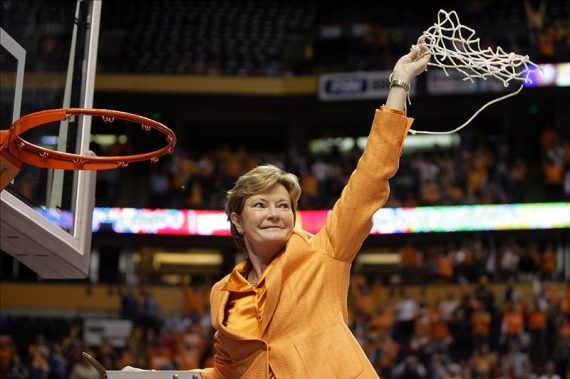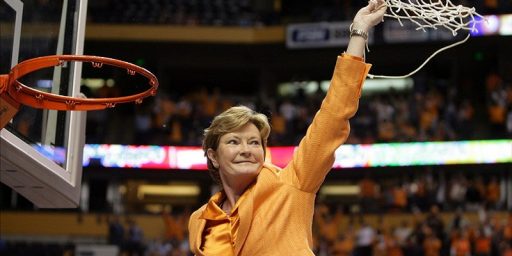Pat Summitt and the Evolution of Women’s Basketball
Pat Summitt's predecessor stepped down as head coach to work on her doctorate.
ESPN’s Gene Wojciechowski asserts that “Pat Summitt is the greatest college basketball coach of our time. At the very least, she’s in the starting five.” He makes his case based on the notion that, “Greatness isn’t measured simply by victories. It is measured by the depth and width of a coach’s impact on the sport itself, on the players, on the university they represent. Find me another basketball coach who transformed and legitimized her sport more than Summitt. Find me another basketball coach whose legacy exceeds hers.”
I’ve fought the “it’s not fair to compare men’s and women’s sporting accomplishments” fight before but am in no mood to do it under the circumstances. Suffice it to say, she’s earned every accolade she gets and we don’t need to cheapen it by comparing her to John Wooden.
In terms of Wojciechowski’s point about Summitt’s impact on the game of women’s basketball, though, here’s a pretty interesting tidbit:
She came to Tennessee in 1974 as a graduate assistant to work on her master’s degree, teach a pair of lower-level physical education classes and, most of all, rehab her injured knee in time for the 1976 Olympics.
For this, college basketball can thank Bettye Giles.
Giles was the women’s athletic director at UT-Martin, which is where Summitt played college basketball. It was Giles, a UT-Knoxville grad and Summitt’s college adviser, who helped arrange the grad assistant position.
Not long after Summitt’s arrival in Knoxville, the women’s basketball head coach decided to take a sabbatical to pursue a doctorate degree. Summitt was offered the job.
Can you imagine the head coach of any BCS program–in any sport–taking a sabbatical to pursue a doctorate? That’s how much women’s basketball has changed in her tenure. And she gets a lot of the credit for it.






Having once been a sportswriter in the South, I’ve covered women’s hoops at the college and pro levels. For some reason, the college game is far more entertaining than the pros – with the attendance reflecting as much. A Vols player would go from playing before 24,000 fans at Thompson–Boling Arena, to a quarter of that in the WNBA.
No point to be made here; just an observation.
@Gold Star for Robot Boy: I just don’t there’s enough interest. There are a handful of women’s programs that have built an enthusiastic following, and they tend to get all the talent. And to capitalize on the “school spirit” thing that’s been built up over the last century or so. The WNBA has fantastic depth of talent but no tradition or rationale for diversion of scarce fan viewing time from established sports.
On the other hand, remember that in 1974 women’t basdketball coaches were actually TEACHING members of the faculty who coached a supplemental duty. Whether women’s basketball becoming part of the university sports-industrial complex is a good thing…well, I’ll just go back to the real news now.
Pat Summit is the most important woman in sports history.
No hyperbole there. She’d be about 1A or 1B with Babe Zahairus.
Some of the other legacies of Pat Summit.
1, The talent is women’s basketball is incredibly shallow. Because there is no pro league, the best players congregate in a few college teams. The best players concentrate themselves unto a few teams and spend their basketball season blowing out most of their opponents.
Since the talent is so shallow, you get the effect that a few universities get some attendance at women’s games but most teams play in front of empty seasons and bored cheerleaders who are forced to attend the games. This years women’s final four had four number one seeds. Boring.
Pat Summit along with Geno Auriemma fought to keep the NCAA tournament on their home courts. The womens game was slow to start playing on neutral sites. If you want to see the years when Tennesse won a national championship, it was the years that they played the first four games at home or near home.
What has also happened to women’s sports is that each women’s sport seems to have only a couple of good teams (women’s soccer, field hockey, lacrosse).
I have great respect for Pat Summit but, I’m not sure that she’s advanced Women’s Basketball all that much. The game has just has not come very far, even at the top level of play, among and between the top 20 teams, blowouts are common. It’s not uncommon to get scores like 82-44.
But then again, on the men’s side, the game is going backwards. Think back to the early mid-80s and the great Big East Teams and the ultra-competitive games and conferences. Now, with one-and-done, the last 2 NCAA championships have nearly unwatchable – Butler/UConn was a disgrace, and this year Kansas was never really in the game against Kentucky.
Greetings:
Having lived through 1950s basketball the first time round, I would have called it a deja vu-lution.
My father-in-law was the head coach of the girl’s team at a BCS university. He was a graduate student. The stories he tells about women’s basketball are really fascinating, from today’s perspective. I have some issues with Title IX, but I never want us to go back to the way things were before it.